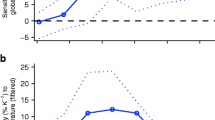Abstract
Summer rainfall variability (October to March) shows inter-annual to multi-decadal fluctuations over a vast area of subtropical Argentina between 28°S–38°S and 65°W–70°W. Statistically significant oscillations of quasi-period in the bands of 18–21, 6, 4 and 2 years can be found throughout the region and intra-regionally, though the latter are variable. The lower frequency variation produces alternating episodes of above and below normal rainfall each lasting roughly 9 years. This quasi-fluctuation appears to be shared with the summer rainfall region of South Africa and were in-phase related one another until mid-1970s. The teleconnection between both subtropical regions could be generated by an atmospheric-oceanic bridge through the global sea surface temperatures (SSTs), particularly those of the equatorial-tropical South Atlantic. From mid-1970s, the alternating wet and dry pattern has been interrupted in the Argentine region producing the longest, as yet unfinished, wet spell of the century. Thus, a significant change of the long-term variation was observed around 1977 toward lower frequencies. Since then the statistical model that explains more than 89% of the variance of the series until 1977, diverges from the observed values in the 1980s and 1990s. In addition the Yamamoto statistical index, employed to detect a climatic jump, reaches its major value in 1973 at the beginning of the current long wet spell. Therefore the change could be located between 1973 and 1977. Application of the t-student's test gives significant differences of mean values for pre-1977 and post-1977 sub-samples from both individual time series and the regional index series. The spectral analysis also shows changes in energy bands in concordance with the features of the change that occurred from mid-1970s. The change gives rise to a significant increment of more than 20% in average of normal rainfall over the region. Conversely, a drought between mid-1980s and the 1990s has been observed in the South African counterpart with severe characteristics, thereby continuing the quasi-18-year oscillation. Consequently, the low-frequency coherent behaviour between both the Argentine and South African regions is lost from the mid-1970s. The analysis of association of wet/dry spells and warm/cold, El Niño/La Niña episodes appears to be not significant at scales of year-to-year variability although at decadal to multi-decadal scales the association could be relevant. More than one process of multi-decadal variability of global SSTs could influence the Argentine summer rainfall region and the former bi-decadal teleconnection. Finally, potential hypothetical factors of change are discussed, such as the strengthening of direct and indirect mechanisms of moisture flux transport associated with global warming, low-level atmospheric circulation changes and/or to SSTs mean condition long-term variations over tropical and subtropical South Atlantic and South Pacific oceans.
Similar content being viewed by others
Author information
Authors and Affiliations
Additional information
Received: 6 March 2000 / Accepted: 21 May 2001
Rights and permissions
About this article
Cite this article
Compagnucci, R., Agosta, E. & Vargas, W. Climatic change and quasi-oscillations in central-west Argentina summer precipitation: main features and coherent behaviour with southern African region. Climate Dynamics 18, 421–435 (2002). https://doi.org/10.1007/s003820100183
Issue Date:
DOI: https://doi.org/10.1007/s003820100183




